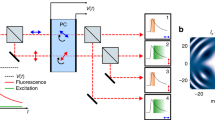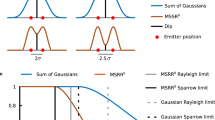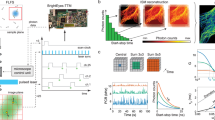Abstract
We developed single-image fluorescence lifetime imaging microscopy (siFLIM), a method for acquiring quantitative lifetime images from a single exposure. siFLIM takes advantage of a new generation of dedicated cameras that simultaneously record two 180°-phase-shifted images, and it allows for video-rate lifetime imaging with minimal phototoxicity and bleaching. siFLIM is also inherently immune to artifacts stemming from rapid cellular movements and signal transients.
This is a preview of subscription content, access via your institution
Access options
Subscribe to this journal
Receive 12 print issues and online access
$259.00 per year
only $21.58 per issue
Buy this article
- Purchase on Springer Link
- Instant access to full article PDF
Prices may be subject to local taxes which are calculated during checkout



Similar content being viewed by others
References
Lin, H.J., Herman, P. & Lakowicz, J.R. Cytometry A 52, 77–89 (2003).
Chen, N.T. et al. PLoS ONE 7, e44947 (2012).
Kuil, J. et al. ChemBioChem 12, 1897–1903 (2011).
Okabe, K. et al. Nat. Commun. 3, 705 (2012).
van der Krogt, G.N.M., Ogink, J., Ponsioen, B. & Jalink, K. PLoS ONE 3, e1916 (2008).
Klarenbeek, J.B., Goedhart, J., Hink, M.A., Gadella, T.W.J. & Jalink, K. PLoS ONE 6, e19170 (2011).
Gadella, T.W.J., van Hoek, A. & Visser, A.J.W.G. J. Fluoresc. 7, 35–43 (1997).
Hanley, Q.S., Subramaniam, V., Arndt-Jovin, D.J. & Jovin, T.M. Cytometry 43, 248–260 (2001).
Lakowicz, J.R. (ed) Princ. Fluoresc. Spectrosc. (Springer, New York, 2006).
Esposito, A., Oggier, T., Gerritsen, H.C., Lustenberger, F. & Wouters, F.S. Opt. Express 13, 9812–9821 (2005).
Esposito, A., Gerritsen, H.C., Oggier, T., Lustenberger, F. & Wouters, F.S. J. Biomed. Opt. 11, 034016 (2006).
Zhao, Q. et al. J. Biomed. Opt. 17, 126020 (2012).
Klarenbeek, J., Goedhart, J., van Batenburg, A., Groenewald, D. & Jalink, K. PLoS ONE 10, e0122513 (2015).
Schneider, P.C. & Clegg, R.M. Rev. Sci. Instrum. 68, 4107–4119 (1997).
Tilly, B.C. et al. Biochem. J. 266, 235–243 (1990).
Tilly, B.C. et al. J. Cell Biol. 110, 1211–1215 (1990).
Hishinuma, S. & Ogura, K. J. Neurochem. 75, 772–781 (2000).
Murakoshi, H., Lee, S.J. & Yasuda, R. Brain Cell Biol. 36, 31–42 (2008).
Claycomb, W.C. et al. Proc. Natl. Acad. Sci. USA 95, 2979–2984 (1998).
Labrousse, A.M. et al. Front. Immunol. 2, 51 (2011).
Johansson, M. et al. J. Cell Biol. 176, 459–471 (2007).
Mitchell, A.C., Wall, J.E., Murray, J.G. & Morgan, C.G. J. Microsc. 206, 233–238 (2002).
Mitchell, A.C., Wall, J.E., Murray, J.G. & Morgan, C.G. J. Microsc. 206, 225–232 (2002).
Ganesan, S., Ameer-Beg, S.M., Ng, T.T.C., Vojnovic, B. & Wouters, F.S. Proc. Natl. Acad. Sci. USA 103, 4089–4094 (2006).
Chen, H. & Gratton, E. Microsc. Res. Tech. 76, 282–289 (2013).
Digman, M.A., Caiolfa, V.R., Zamai, M. & Gratton, E. Biophys. J. 94, L14–L16 (2008).
Gadella, T.W.J., Jovin, T.M. & Clegg, R.M. Biophys. Chem. 48, 221–239 (1993).
Acknowledgements
We thank J. Klarenbeek for plasmids encoding EPAC sensors and W. Zwart and J. Neefjes for providing plasmids encoding GFP-Rab7 and RFP-RILP. This research is funded from ERC grant 249997, awarded to T. Sixma; KWF grant NKI2010-4626, awarded to K.J.; and IOP Project IPD083412A awarded by Agentschap NL to K.J. and I.T.Y. The LI2CAM FLIM-camera was purchased with help of the Maurits and Anna de Kock foundation.
Author information
Authors and Affiliations
Contributions
M.R., K.M.K. and Q.Z. performed the experiments and M.R., K.M.K., B.v.d.B., I.T.Y. and K.J. analyzed the data. J.H., S.d.J., B.v.d.B. and K.J. optimized hardware and software for siFLIM. T.W.J.G., B.v.d.B., K.M.K. and K.J. developed the mathematical framework for siFLIM. K.M.K. and K.J. carried out the sensitivity analysis. I.T.Y. led the team developing the MEMFLIM chip; J.G. and M.M. developed and tested the Gq sensor; K.J., M.R., K.M.K., B.v.d.B. and I.T.Y. wrote the manuscript and K.J. conceived and supervised the study.
Corresponding author
Ethics declarations
Competing interests
M.R., K.M.K., Q.Z., B.v.d.B., J.G., M.M., T.W.J.G., I.T.Y. and K.J. declare no competing financial interests. J.H. and S.d.J. are employees of Lambert Instruments.
Supplementary information
Supplementary Text and Figures
Supplementary Figures 1–7, Supplementary Notes 1 and 2, and Supplementary Discussion (PDF 5440 kb)
Rapid Ca2+ oscillations as detected by siFLIM
Lifetime data are calculated from the MEMFLIM image pair recorded at Φ = 60°. HeLa cells loaded with fluorescent calcium indicator were stimulated with histamine (t = 20 s), with ionomycin (t = 210 s) followed by addition of extra Ca2+ (3 mM at t = 220 s). The intensity line-plots are taken from the ROIS with corresponding colors. The kymograph shows lifetime data taken from the rectangle indicated in white. Sampling rate is 6 Hz. (AVI 23186 kb)
siFLIM is immune to movement artefacts
Lifetime data recorded by 12-phase frequency-domain FLIM (left) and by siFLIM (right) from HeLa cells expressing GFPRab7 and mRFP-RILP. Note that fast-moving vesicles display artefacts in the 12-phase data but not in the siFLIM results. (AVI 1036 kb)
Rights and permissions
About this article
Cite this article
Raspe, M., Kedziora, K., van den Broek, B. et al. siFLIM: single-image frequency-domain FLIM provides fast and photon-efficient lifetime data. Nat Methods 13, 501–504 (2016). https://doi.org/10.1038/nmeth.3836
Received:
Accepted:
Published:
Issue Date:
DOI: https://doi.org/10.1038/nmeth.3836
This article is cited by
-
Radiative lifetime-encoded unicolour security tags using perovskite nanocrystals
Nature Communications (2021)
-
Dynamic FRET-FLIM based screening of signal transduction pathways
Scientific Reports (2021)
-
A turquoise fluorescence lifetime-based biosensor for quantitative imaging of intracellular calcium
Nature Communications (2021)
-
Spectro-temporal encoded multiphoton microscopy and fluorescence lifetime imaging at kilohertz frame-rates
Nature Communications (2020)
-
Electro-optic imaging enables efficient wide-field fluorescence lifetime microscopy
Nature Communications (2019)



